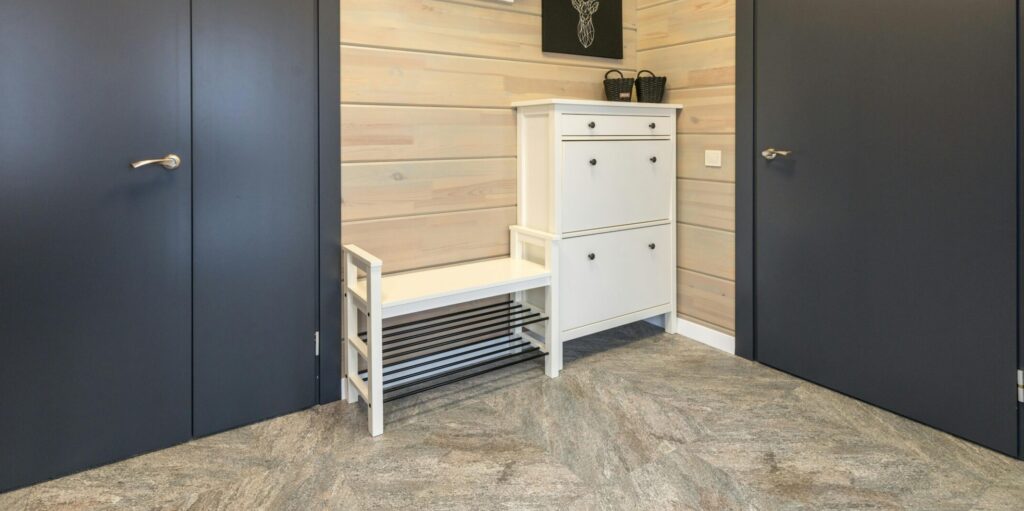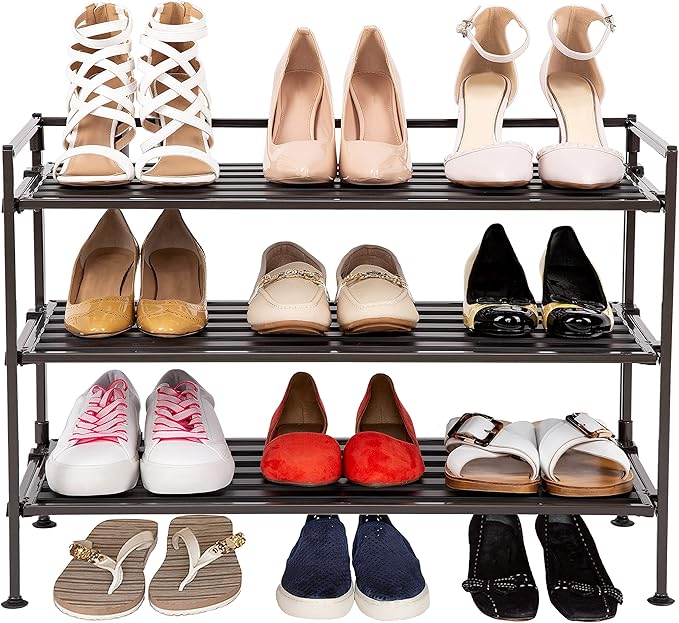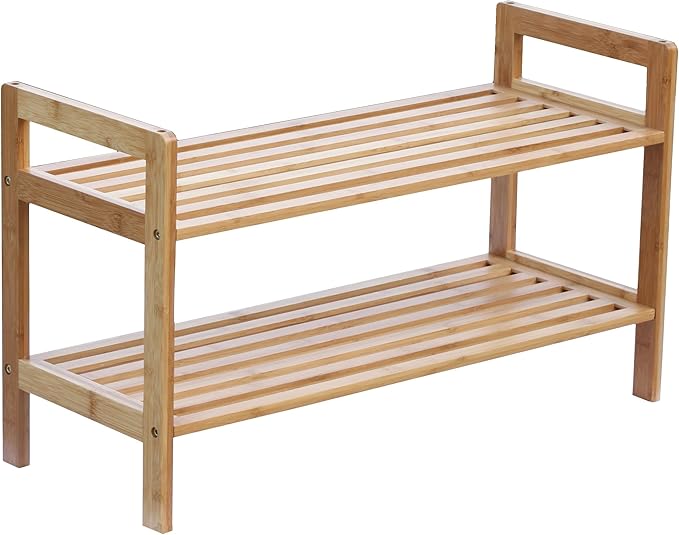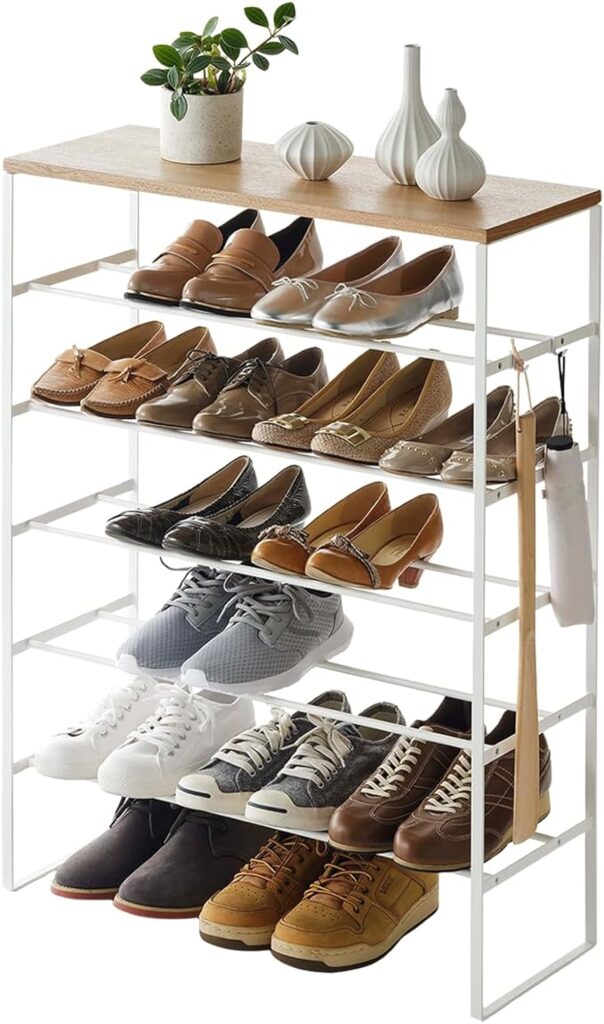Advertiser Disclosure
We independently review everything we recommend. When you buy through our links, we may earn a commission.
The Best Shoe Rack

Let’s face it – shoe storage is one of those everyday problems that can make or break your morning routine. Whether you’re dealing with a cramped entryway, overflowing closet, or just tired of tripping over scattered footwear, the right shoe rack isn’t just about organization. It’s about creating a functional space that works for your lifestyle.
The shoe storage market has exploded in recent years, with options ranging from simple three-tier racks to sophisticated rotating systems. However, choosing the wrong type can leave you more frustrated than when you started. That’s why we’ve created this comprehensive guide to help you navigate the world of shoe storage and find the perfect solution for your specific needs.
Everything We Recommend
🏆
Top pick
Measures 26.5″ W x 12.25″ D x 18.5″ H, offering spacious storage in a compact footprint.
Stack up to 3 units high to maximize vertical storage and save floor space.
Three shelves (25.5″ W x 11.6″ D) with 5.5″ tier spacing hold shoes, clothes, and bags, plus 3.25″ under clearance for low-profile items.
Durable foldable steel frame supports up to 30 lbs. per shelf with five 1″ wide resin slats.
Interlock system connects multiple units side-by-side for a custom modular storage setup.
Covered by multiple U.S. patents, ensuring a uniquely designed and functional storage solution.
Ideal for bedrooms, entryways, closets, offices, pantries, and garages for versatile indoor use.
💎
Runner-up
Holds up to 6 pairs of adult-sized shoes, keeping your space organized and clutter-free.
Versatile design also accommodates bags, hats, and other accessories for multifunctional storage.
Features a modern slatted surface that promotes air circulation to keep items fresh.
Includes soft, rounded side handles for easy lifting and transport around your home.
Upgrade Pick
Stores up to 18 shoes or 21 heels, offering generous capacity for larger footwear collections.
Slim metal frame delivers a clean, minimalist look while maximizing vertical storage.
Built with five durable wooden shelves, each supporting up to 3 kg for stable, long-term use.
Simple to assemble with included hardware and clear step-by-step instructions.
Ideal for entryways, hallways, closets, or mudrooms to instantly organize any living space.
Different Types of Shoe Racks
Traditional Tier Racks: The Foundation of Shoe Storage
Traditional tiered shoe racks remain the most popular choice for good reason. These straightforward designs typically feature 3-10 horizontal shelves that can accommodate various shoe sizes and styles. The beauty of tier racks lies in their simplicity and versatility.
Most tier racks hold between 12-30 pairs of shoes, depending on their size and configuration. The expandable versions offer particular value since they can grow with your collection. When selecting a tier rack, consider the ceiling height in your intended space, as taller units provide better storage density but may not fit under low-hanging closet rods.
Over-the-Door shoe Organizers: Maximizing Vertical Space
Over-the-door shoe organizers have become increasingly sophisticated, moving beyond the basic hanging shoe bags of the past. Modern versions feature sturdy metal frames with individual pockets or slots that keep shoes secure and easily accessible.
These shoe organizers work particularly well in smaller spaces where floor space is at a premium. They typically hold 12-24 pairs of shoes and can be installed without any tools or permanent modifications to your door. The key consideration is door clearance – measure the space between your door and adjacent walls to ensure smooth operation.
Rotating Shoe Racks: The Space-Saving Solution
Rotating shoe racks represent a more advanced approach to shoe storage, offering maximum capacity in a compact footprint. These cylindrical units can hold 20-40 pairs of shoes while occupying roughly the same floor space as a traditional chair.
The rotating mechanism allows easy access to your entire collection without having to move other shoes. However, these systems typically require more assembly time and may not accommodate very tall boots or unusually shaped footwear as effectively as traditional racks.
Bench Storage: Dual-Purpose Functionality
Shoe storage benches combine seating with storage, making them ideal for entryways where you need both functions. These units typically feature lift-up seats that reveal storage compartments underneath, along with open shelving or cubbies for frequently used shoes.
The weight capacity of the bench top is crucial – look for models that can support at least 250 pounds for reliable seating. Some advanced models include additional features like coat hooks or umbrella stands to create a complete entryway organization system.
Modular Cube Systems: Customizable Storage
Modular cube systems allow you to build custom shoe storage solutions by combining individual storage cubes. Each cube typically holds 1-2 pairs of shoes, and multiple cubes can be stacked or arranged in various configurations to fit your space.
These systems offer the most flexibility but require more planning and often cost more per pair stored than traditional racks. They work best for people with diverse shoe collections who want to organize by type, season, or frequency of use.
The Best Shoe Rack Our Picks
The Seville Classics 3-Tier Resin Slatted Shoe Rack SHE15882 represents exceptional value in this price range. This thoughtfully designed rack addresses one of the most common frustrations with shoe storage: durability in humid environments. The resin construction means you can place it anywhere from your basement to your garage without worrying about rust or moisture damage that plagues metal alternatives.
What makes this rack particularly impressive is its slatted design, which allows proper air circulation around your shoes. This feature becomes invaluable if you frequently deal with wet shoes from rain or snow, as the ventilation prevents that musty smell that can develop in enclosed storage. The three-tier configuration accommodates up to 15 pairs of shoes while maintaining easy access to each level.
The rack’s lightweight yet sturdy construction makes it incredibly versatile. You can easily move it from the closet to the entryway to the garage as your needs change, something that heavier wooden or metal racks simply cannot match. For families with active lifestyles who need reliable storage that can handle everything from muddy hiking boots to delicate dress shoes, this rack delivers remarkable performance at an accessible price point.
The Oceanstar 2-Tier Bamboo Shoe Rack SR1309 stands out as an exceptional choice in this category. This elegant rack transforms the mundane task of shoe storage into something that enhances your home’s aesthetic. The rich bamboo construction brings warmth and sophistication to any space, whether it’s tucked into a bedroom closet or displayed prominently in your entryway.
What sets this rack apart is how it solves the common problem of shoe storage looking like an afterthought in home decor. The natural bamboo finish coordinates beautifully with both modern and traditional interiors, making it perfect for style-conscious homeowners who refuse to compromise on appearance. The two-tier design holds up to 8 pairs of shoes while maintaining an open, airy feel that doesn’t overwhelm smaller spaces.
The environmental benefits make this rack particularly appealing to eco-conscious consumers. Bamboo grows incredibly fast and regenerates naturally, making it one of the most sustainable materials available. You’re not just organizing your shoes – you’re making a choice that reflects your values while enjoying furniture-quality construction that will last for years.
Many models in this range also include assembly improvements like pre-drilled holes and better hardware, making setup straightforward and secure.
The Yamazaki Home 6 Tier Wood Top Shoe Rack 3369-P exemplifies premium shoe storage done right. This sophisticated rack addresses the perpetual challenge of maximizing storage capacity without sacrificing style or functionality. The six-tier design accommodates up to 24 pairs of shoes, making it perfect for large families or serious shoe enthusiasts who need serious storage capacity.
What makes this rack truly exceptional is its intelligent design that turns the top surface into valuable real estate. The solid wood top provides a stable platform for setting down keys, bags, or other items as you come and go. This transforms the rack from simple storage into a functional piece of furniture that serves multiple purposes in your daily routine.
The tall, narrow profile maximizes vertical space while minimizing the floor footprint – a brilliant solution for apartment dwellers or anyone dealing with limited square footage. The clean lines and natural wood finish create a sophisticated appearance that improves the look of your space rather than detracting from it.
For busy professionals who need to keep dress shoes, athletic shoes, and seasonal footwear organized and accessible, this rack delivers remarkable functionality. The height makes it easy to organize shoes by category, with everyday shoes at eye level and seasonal items stored higher or lower. The sturdy construction ensures it can handle the weight of a substantial shoe collection without wobbling or sagging over time.
These racks typically offer better long-term value through improved durability and features that adapt to changing needs. The investment makes sense if you have a large shoe collection or plan to use the rack for many years.
Key Features That Matter Most
Material Quality and Durability
The construction material significantly impacts both the longevity and appearance of your shoe rack. Professional organizers recommend opting for metal or wood (like bamboo) when it comes to shoe racks, as these materials are more durable, easy to clean, and last a lifetime compared to their plastic counterparts.
Metal racks, particularly those made from steel or aluminum, offer excellent strength-to-weight ratios and resist warping under heavy loads. Wood racks provide a more premium appearance but require occasional maintenance to prevent moisture damage. Plastic racks work well for temporary solutions or children’s shoes, but may not withstand heavy use over time.
Weight Capacity and Stability
Understanding weight capacity is crucial for preventing rack failure and ensuring safety. A typical pair of shoes weighs between 1-3 pounds, but boots and athletic shoes can weigh significantly more. Calculate your total shoe weight and choose a rack with at least 50% more capacity than your current needs to accommodate future purchases.
Stability features like anti-tip mechanisms, wide bases, and wall anchoring options prevent accidents and protect your floors. Look for racks with adjustable feet to compensate for uneven surfaces, particularly important in older homes or basements.
Size and Capacity Considerations
Shoe rack capacity is typically measured in pairs, but this can be misleading since shoe sizes vary dramatically. A rack that holds 20 pairs of women’s flats might only accommodate 15 pairs of men’s boots. Consider your specific collection when evaluating capacity claims.
Height adjustability adds significant value, allowing you to accommodate different shoe types without wasted space. Some racks offer removable shelves or adjustable shelf heights specifically for this purpose.
Ease of Assembly and Maintenance
Assembly complexity varies widely among shoe rack designs. Simple tier racks often require minimal tools and can be assembled in 15-30 minutes, while complex rotating systems may take several hours and require multiple people.
Maintenance requirements also differ by design and material. Metal racks typically need only occasional wiping with a damp cloth, while wood racks may require periodic conditioning. Consider your willingness to perform ongoing maintenance when selecting materials.
Space-Specific Recommendations
Small Apartments and Studios
In small living spaces, every square foot counts. Over-the-door organizers and under-bed storage solutions maximize your shoe storage without claiming precious floor space. Look for slim-profile racks that fit in narrow spaces like between furniture pieces or along walls.
Vertical storage becomes particularly important in small apartments. Tall, narrow racks that extend toward the ceiling provide more storage density than wide, low units. Consider racks with a footprint of 12 inches or less to fit in tight spaces.
Walk-in Closets
Walk-in closets offer the most flexibility for shoe storage solutions. You can combine multiple rack types to create a comprehensive system that organizes shoes by type, season, or frequency of use. Consider dedicated sections for dress shoes, athletic wear, and seasonal items.
Built-in solutions or custom shelving systems work particularly well in walk-in closets since you can tailor the storage to your specific collection. However, freestanding racks offer more flexibility if you move frequently or like to rearrange your storage.
Entryways and Mudrooms
Entryway shoe storage requires durability and easy access since these areas experience heavy traffic and varying weather conditions. Bench storage combinations work particularly well here, providing both storage and a convenient place to put on shoes.
Water resistance becomes important in entryway applications, especially if you live in an area with frequent rain or snow. Look for racks with drainage features or water-resistant materials that can handle wet shoes without damage.
Bedroom Storage
Bedroom shoe storage should balance functionality with aesthetics since the rack will be visible in your personal space. Consider how the rack’s appearance complements your bedroom decor and whether it needs to be concealed or can serve as a design element.
Noise levels also matter in bedroom applications. Metal racks may create more noise when shoes are added or removed, while wood or fabric-covered options operate more quietly.
Professional Organizer Tips for Maximum Efficiency
Seasonal Rotation Strategies
Professional organizers recommend rotating shoes seasonally to maximize accessibility and protect off-season footwear. Store winter boots during summer months and sandals during winter to keep frequently used shoes easily accessible.
Use clear storage boxes or vacuum-sealed bags for off-season shoes, labeling them clearly for easy identification. This approach reduces the storage capacity needed for your primary shoe rack while protecting shoes from dust and damage.
Organizing by Frequency of Use
Arrange shoes on your rack based on how often you wear them, with daily shoes at eye level and special occasion shoes on higher or lower shelves. This strategy reduces the time spent searching for shoes and minimizes wear on both the rack and your shoes.
Consider creating designated zones for different activities – work shoes in one area, athletic shoes in another, and casual shoes in a third section. This approach makes it easier to find appropriate footwear quickly.
Maintenance and Care Best Practices
Regular maintenance extends the life of both your shoes and your storage system. Clean your rack monthly with appropriate cleaners for the material, and inspect for wear or damage that might require attention.
Allow wet shoes to dry completely before placing them on the rack to prevent moisture damage and odor issues. Consider using cedar shoe inserts or moisture-absorbing packets to maintain optimal conditions.
Common Mistakes to Avoid
Underestimating Space Requirements
Many people underestimate the space needed for effective shoe storage. Measure your available space carefully, including height, width, and depth, before purchasing a rack. Remember to account for door clearances and foot traffic patterns.
Also, consider the space needed to access shoes comfortably. Racks placed too close to walls or other furniture become difficult to use and may not accommodate all shoe sizes effectively.
Ignoring Weight Distribution
Improper weight distribution can cause rack failure or instability. Place heavier shoes like boots on lower shelves and lighter shoes higher up. This approach improves stability and makes the rack easier to use.
Avoid overloading individual shelves beyond their weight capacity, even if the overall rack can handle the total weight. Uneven loading can cause warping or structural failure over time.
Choosing Style Over Function
While appearance matters, prioritizing style over functionality often leads to frustration. A beautiful rack that doesn’t hold your shoes effectively or fit your space properly won’t solve your storage problems.
Consider how the rack will look when fully loaded with your actual shoes, not just the styled photos from the manufacturer. Real-world usage often looks different from marketing materials.
Special Considerations for Different Shoe Types
Athletic and Sports Shoes
Athletic shoes present unique storage challenges due to their size, shape, and ventilation needs. Many athletic shoes are bulkier than dress shoes and may not fit well on standard racks designed for traditional footwear.
Consider racks with adjustable or removable shelves to accommodate athletic shoes’ varying heights. Ventilation becomes important for athletic shoes to prevent odor and moisture buildup.
High Heels and Dress Shoes
High heels require special consideration due to their shape and delicate construction. Look for racks with angled shelves or special heel supports that prevent damage to the shoe structure.
Dress shoes benefit from individual compartments or sufficient spacing to prevent scuffing. Consider felt-lined shelves or individual shoe bags for particularly expensive or delicate footwear.
Boots and Tall Footwear
Boots challenge most standard shoe racks due to their height and weight. Look for racks with removable shelves or adjustable configurations that can accommodate tall boots without wasting space.
Some racks include special boot storage areas or clips that support boots upright. This feature prevents creasing and maintains the boot’s shape over time.
Technology and Smart Storage Solutions
App-Connected Inventory Systems
Modern shoe storage increasingly includes technology integration, with some systems offering app connectivity to track your collection and suggest outfits. These systems typically include RFID tags or barcode systems to monitor individual shoes.
While these features add convenience, they also increase complexity and cost. Consider whether the technology benefits justify the additional expense for your specific needs.
Climate Control Features
Advanced shoe storage systems may include climate control features like humidity regulation or temperature monitoring. These features protect expensive footwear but add significantly to the cost and complexity.
These systems work best for serious collectors or those living in extreme climates where standard storage might damage shoes over time.
Environmental and Sustainability Considerations
Eco-Friendly Materials
Environmentally conscious consumers should consider racks made from sustainable materials like bamboo, recycled metal, or responsibly sourced wood. These materials often offer comparable durability while reducing environmental impact.
Bamboo racks have gained popularity due to their renewable nature and attractive appearance. They typically cost more than plastic alternatives but offer better durability and environmental benefits.
Longevity and Repairability
Choosing durable, repairable shoe racks reduces environmental impact over time. Look for racks with replaceable parts or modular designs that can be updated or expanded rather than replaced entirely.
Consider the total lifecycle cost, including disposal, when evaluating options. A more expensive rack that lasts significantly longer may offer better environmental and economic value.
Installation and Setup Tips
Tools and Preparation
Most shoe racks require basic tools like screwdrivers, Allen wrenches, or rubber mallets. Read the installation instructions completely before beginning assembly to ensure you have all the necessary tools and understand the process.
Prepare your installation area by clearing adequate space for assembly and having good lighting. Many racks require two people for safe assembly, particularly larger or heavier models.
Safety Considerations
Follow all safety guidelines during installation, including wearing safety glasses when drilling or hammering. Ensure the rack is properly anchored if recommended by the manufacturer, particularly for tall or heavy units.
Test the rack’s stability before loading it with shoes. Add shoes gradually and check for any signs of instability or stress that might indicate improper assembly.
Maintenance and Long-Term Care
Cleaning and Upkeep
Regular cleaning maintains both appearance and functionality. Use appropriate cleaners for your rack’s material – wood cleaners for wood racks, metal polish for metal racks, and mild soap for plastic racks.
Check hardware periodically for looseness or wear. Tighten screws and replace worn components as needed to maintain stability and safety.
Troubleshooting Common Issues
Common problems include shelf sagging, wobbling, or difficulty accessing shoes. Many issues result from overloading, improper assembly, or normal wear over time.
Address problems promptly to prevent further damage. Contact the manufacturer if issues occur during the warranty period, as many problems are covered under standard warranties.
Future Trends in Shoe Storage
Emerging Technologies
The shoe storage industry continues to evolve with new technologies and materials. Smart storage systems, automated retrieval mechanisms, and advanced materials promise to improve functionality and convenience.
3D printing technology may eventually enable custom shoe storage solutions tailored to specific collections and spaces. However, these technologies remain expensive and primarily serve niche markets.
Changing Consumer Preferences
Consumer preferences increasingly favor multifunctional furniture and space-saving solutions. This trend drives innovation in combination storage systems and modular designs that adapt to changing needs.
Sustainability concerns also influence design choices, with manufacturers focusing on recyclable materials and products designed for longevity rather than replacement.
Conclusion: Finding Your Perfect Shoe Storage Solution
Choosing the right shoe rack depends on your specific needs, space constraints, and budget. The key is understanding your priorities and matching them with the appropriate features and design. Whether you need a simple tier rack for basic organization or a sophisticated rotating system for a large collection, the right solution exists for every situation.
Remember that the best shoe rack is one that you’ll use consistently. Consider your daily routines, the types of shoes you own, and your long-term storage needs when making your decision. A well-chosen shoe rack not only organizes your footwear but also streamlines your daily routine and protects your investment in quality shoes.
The shoe storage market offers excellent options at every price point, from budget-friendly tier racks to premium custom solutions. By understanding the features that matter most for your situation and avoiding common mistakes, you can find a solution that transforms your shoe storage from chaos to organized efficiency.
Take time to measure your space, inventory your shoes, and consider your specific needs before making a purchase. With the right shoe rack, you’ll wonder how you ever managed without organized, accessible storage for your footwear collection.


